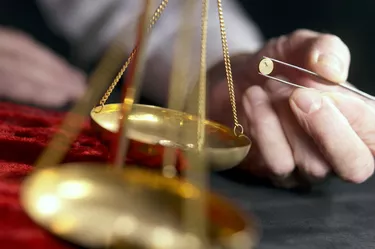
Ultimately, the value of any object is how much someone is willing to pay for it. The going rate of a particular coin or piece of jewelry can be more or less than the intrinsic value of the metal it contains based on who's buying and who's selling. The weight value, also known as the melt value, is usually a good reference point. For purposes of measuring the weight value of gold, use the purity of the metal content in decimals.
Step 1
Calculate the purity of gold. This is most commonly given in terms of karats (k), with 24k gold being 100 percent pure. Therefore, 12k gold is 50 percent (0.5) pure, 18k gold is 75 percent (0.75) pure, and 9k gold is 37.5 percent (0.375) pure. Some gold bullion will state the purity as a decimal, such as 0.999 (99.9 percent) or 0.95 (95 percent).
Video of the Day
Step 2
Calculate the purity of silver. Sterling silver is typically 92.5 percent (0.925) pure. Though it can be more, without a specific marking of purity, this is the assumed amount for sterling silver. Fine silver is typically 99.9 percent (0.999) pure or better, though some bullion is lower in purity, such as Mexican silver at 95 percent (0.95) and British silver at about 95.8 percent (.958). Many U.S. coins minted before 1964 (and a very few afterward) also have real silver content.
Step 3
Multiply the purity by the spot price. The spot price of gold and silver is the going price as determined by international spot markets. Multiplying the spot price by the purity of the gold or silver allows you to calculate the price per unit of weight.
Step 4
Convert weight into ounces. The spot prices of gold and silver are given in troy ounces, so to measure the weight value of an object, you must also convert its weight to ounces. Measure the weight on a scale reading in troy ounces, or by converting the known weight into troy ounces using a conversion calculator.
Step 5
Multiply by weight. Multiply the product calculated in step 3 by the total weight. The result is the weight value in gold or silver of the object. Note that because the spot price fluctuates, the weight price is also subject to change.
Tip
Bullion is almost always marked with its purity and typically comes in whole number sizes, making the weight value easy to calculate.
Warning
The weight value of scrap metal is typically a 10 percent to 20 percent discount to the spot market because it literally must be melted down in order to become a resellable product. Therefore, deduct this percentage from your calculation to reach a more realistic sale value for scrap gold or silver.
Video of the Day